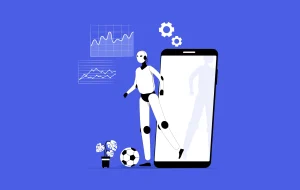
Forget the old-school gambler with a lucky rabbit’s foot. The modern approach to betting is less about gut feelings and more about gigabytes of data. It’s a world where algorithms sift through historical stats, player conditions, and even weather patterns to find an edge.
Honestly, it’s a seismic shift. We’re talking about using AI and data analytics for predictive betting models, a practice that’s turning an age-old game of chance into a sophisticated field of probabilistic forecasting. Let’s dive into how it actually works.
The Engine Room: What Fuels a Predictive Model?
Think of a predictive model as a high-performance car. The data is the fuel, and the AI is the complex engine that burns it for power. Without quality fuel, even the best engine sputters.
The Data Smorgasbord
These models are ravenous. They consume a staggering variety of data points. We’re talking about the obvious stuff, sure:
- Head-to-head history
- Player performance stats (goals, assists, yards gained, etc.)
- Team standings and recent form
But the real magic, the secret sauce, often lies in the non-obvious. Things like:
- Travel distance and fatigue metrics
- Player tracking data (distance covered, sprint speed)
- In-play event streams (momentum shifts, possession percentages)
- Even social media sentiment—is a key player distracted by off-field issues?
The AI That Makes Sense of It All
Once you have the data, you need a brain to process it. That’s where machine learning comes in. Algorithms like Random Forests and Gradient Boosting Machines (GBM) are particularly good at this. They don’t just look for simple correlations; they find complex, hidden patterns a human would likely miss.
For instance, a model might discover that a specific football team’s chance of winning drops significantly when playing on a wet pitch against a left-handed quarterback. You know, the kind of nuanced insight that slips past the naked eye.
Building Your Own Model: A Realistic Glimpse
Okay, so how does one actually go about building a sports betting model with AI? It’s not a weekend project, but the process follows a logical path.
The Step-by-Step Grind
It’s a grind, honestly. Here’s a simplified breakdown:
- Data Acquisition & Cleaning: This is the unglamorous 80% of the work. You gather data from APIs, scrape websites (where legal, of course), and then spend ages cleaning it. Missing values, inconsistent formatting—it all has to be fixed. Garbage in, garbage out, as they say.
- Feature Engineering: This is where you get creative. You take raw data and create new, more powerful inputs (“features”). Instead of just “points scored,” you might create “average points scored in the last 5 away games.” You’re giving the AI better tools to work with.
- Model Selection & Training: You choose your algorithm (like the GBM we mentioned) and “train” it on historical data. You show it thousands of past games and their outcomes, letting it learn the patterns that led to those results.
- Backtesting: This is the moment of truth. You run your trained model on a period of historical data it hasn’t seen before. Did it accurately predict the outcomes? This is where you see if you’ve built a genius or a dud.
The Human in the Loop: Where Gut Feeling Still Matters
Here’s a critical point that often gets lost: AI isn’t a silver bullet. The most successful bettors use AI as a powerful tool, not an oracle. The model might spit out a 68% probability of a home win. But then you, the human, need to apply context.
Is the star striker recovering from a flu? Was there a major team controversy this week? These are qualitative factors—the “unknown unknowns”—that a model can’t quantify. The real edge comes from combining the cold, hard data with smart, situational awareness.
Common Pitfalls and How to Sidestep Them
It’s not all smooth sailing. Many aspiring modelers run aground on the same rocks.
Overfitting is the big one. This is when your model becomes too tailored to the historical data it was trained on. It memorizes the past perfectly but fails miserably at predicting the future. It’s like a student who memorizes the textbook but can’t apply the concepts to a new problem. You combat this with rigorous backtesting and by keeping your model appropriately simple.
Another huge challenge is the dynamic nature of sports. The game evolves. Rules change. A new, revolutionary playing style emerges. Your model can become obsolete if it’s not constantly retrained with fresh data. It’s a living thing, not a statue you build once and forget.
The Future is Already Here: What’s Next?
The frontier is pushing into even wilder territory. We’re seeing the early stages of computer vision being used. AI that can analyze video footage to track player movements, formations, and even biomechanics to assess fatigue or injury risk.
And then there’s the integration of alternative data streams. Think about it—could anonymized mobile location data showing stadium traffic patterns predict game-day attendance and, by extension, home-field advantage? It sounds like science fiction, but it’s the kind of data point being explored right now.
The landscape is changing, fast. The barrier to entry isn’t really money anymore; it’s expertise. It’s the knowledge to handle the data, to understand the math, and—crucially—to respect its limits. The future of predictive betting models in sports isn’t about finding a guaranteed win. It’s about consistently identifying those small, valuable discrepancies between what the model predicts and what the market offers. It’s a marathon, not a slot machine.






